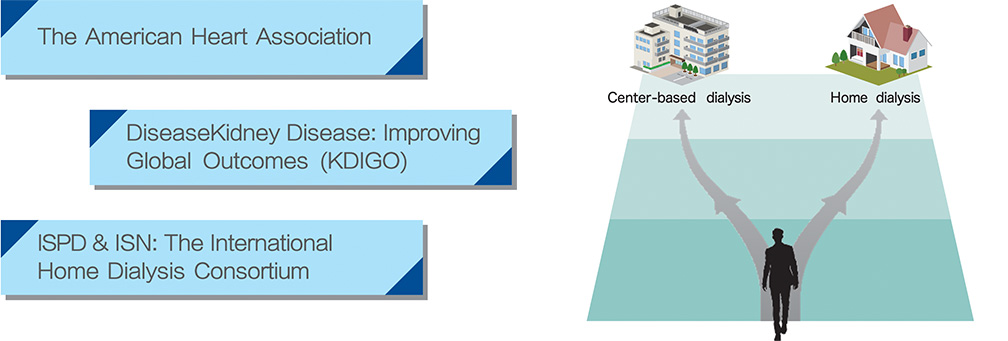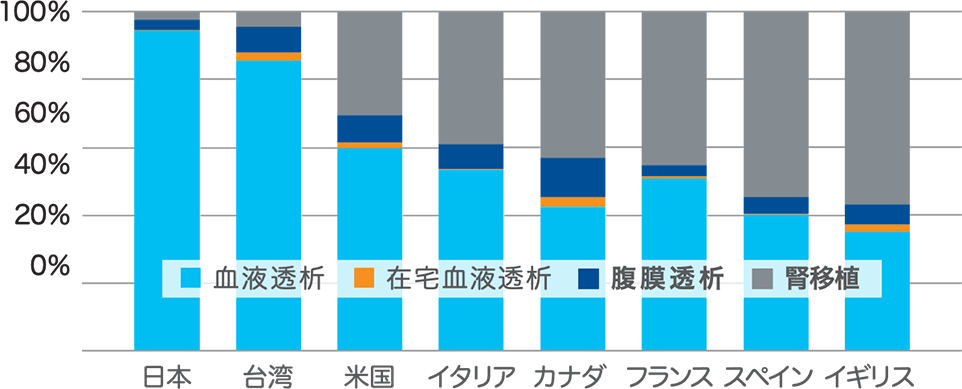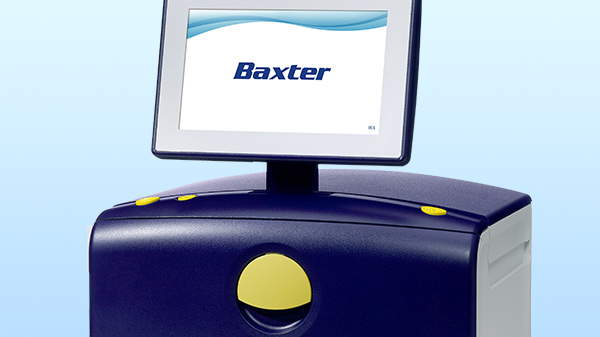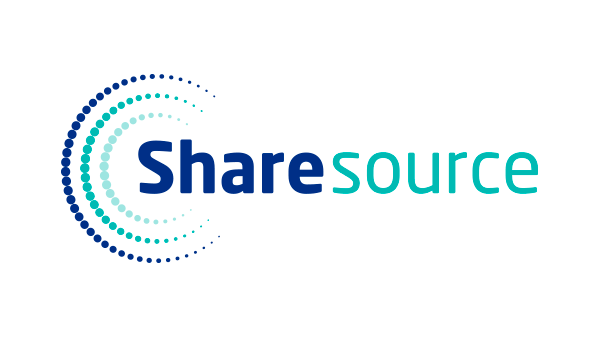
「おうち透析」とは:バクスターは、在宅での治療となる腹膜透析および在宅血液透析をより多くの患者さんに認知していただくために「おうち透析」と名付けました。
当ページにおいては「おうち透析」:腹膜透析に関しての説明ページといたします。
Life Goalに応じた腎代替療法の選択
-
メッセージ〜患者さんの「Life Goal(人生目標)」に寄り添った腎代替療法の説明とは?
( R50097 Ver1.0 )
「おうち透析」が求められる背景
健康的で質の高い生活を送れるよう、学会、アカデミアが在宅透析(Home Dialysis)の普及を支援しています1,2,3。

論文2. Figure 1より改変
おうち透析(腹膜透析)には臨床面やライフスタイルの観点から
以下に挙げるような報告があります4-15。
![]()
- 臨床
- 腹膜透析はその臨床アウトカムから、腎代替療法の一つの選択肢として、推奨されるべき治療法であることが示唆されている5,6
海外では以下の報告があります
- ・治療に対する患者満足度の割合は、85%と示された4
- ・残存腎機能を保持し、患者生存率においては血液透析と同様の臨床アウトカムを示した5,6
- ・腹膜透析患者数は世界的に増加しており、2009年からほぼ倍増している7
- ・遠隔患者管理(RPM)を伴ったAPDは、RPMを伴わないAPDと比較して医療者の負担を低減した8
- ・少ない受診回数により、感染症への曝露のリスク低減が示唆された9
- ・高齢者の認知症の進行を遅らせる可能性が示唆された10
![]()
- ライフスタイル
- 腹膜透析は患者さんと家族に対し、高い治療満足度や個人のライフゴールの達成といったQOLの向上をサポートする可能性がある
- ・腹膜透析の選択にあたり、患者さんや家族はライフスタイルを重要視している11
- ・海外では、腹膜透析は慢性腎不全患者の50%に選択されていると報告がある12
- ・腹膜透析は厚生労働省が推進する地域包括ケアのモデルケースとなりやすい13
- ・腹膜透析は、ISPDやKDOQIガイドラインで要求されるいくつかのライフスタイルの利点をもった目標指向型のケアを可能にする14,15
「連携および在宅医療の推進」は厚生労働省が示す日本の方向性
- 日本は、諸外国と比べ、腹膜透析や腎移植が普及していない
- ▼
- 患者のQOLの観点から、腹膜透析や腎移植の普及推進が必要
Ref: MHLW. 平成30年度診療報酬改定の概要. Mar. 5, 2018.
https://www.mhlw.go.jp/stf/seisakunitsuite/bunya/0000196352.html
-
Sarnak MJ, Auguste BL, Brown E, et al. Cardiovascular Effects of Home Dialysis Therapies: A Scientific Statement From the American Heart Association. Circulation. 2022; 146(11): e146-e164.
-
Perl J, Brown EA, Chan CT, et al. Home dialysis: conclusions from a Kidney Disease: Improving Global Outcomes (KDIGO) Controversies Conference. Kidney Int. 2023; 103(5): 842-858.
-
Edwina A. Brown, Vivekhand Jha on behalf ofthe Steering Committee. Introducing the International Home Dialysis Consortium. KI Reports. Published May 02, 2023.
-
Rubin HR, Fink NE, Plantinga LC, et al. Patient Ratings of Dialysis Care With Peritoneal Dialysis vs Hemodialysis. JAMA. 2004; 291(6): 697-703.
-
Jansen MA, et al. Predictors of the rate of decline of residual renal function in incident dialysis patients. Kidney Int. 2002; 62: 1046-1053.
-
Yeates, K., Zhu, N., Vonesh, E., et al. Hemodialysis and peritoneal dialysis are associated with similar outcomes for end-stage renal disease treatment in Canada. Nephrol Dial Transplant. (2012) 27: 3568‒3575.
-
United States Renal Data System. 2021 USRDS Annual Data Report: Epidemiology of kidney disease in the United States: End Stage Renal Disease: Chapter 2. Home Dialysis. National Institutes of Health, National Institute of Diabetes and Digestive and Kidney Diseases
-
Milan Manani S, Rosner MH, Virzì GM, et al. Longitudinal Experience with Remote Monitoring for Automated Peritoneal Dialysis Patients. Nephron. 2019; 142(1): 1-9.
-
Martin DE, et al. Ethics of kidney care in the era of COVID-19. Kidney Int. 2020; 98(6): 1424-1433.
-
Wolfgram DF, Szabo A, Murray AM, et al. Risk of dementia in peritoneal dialysis patients compared with hemodialysis patients. Perit Dial Int. 2015; 35(2): 189-198.
-
Manera KE, Johnson DW, Craig JC, et al; SONG-PD Workshop Investigators. Establishing a Core Outcome Set for Peritoneal Dialysis: Report of the SONG-PD (Standardized Outcomes in Nephrology-Peritoneal Dialysis) Consensus Workshop. Am J Kidney Dis. 2020; 75(3): 404-412.
-
Prieto-Velasco M, et al. The Concordance between Patientsʼ Renal Replacement Therapy Choice and Definitive Modality: Is It a Utopia? PLoS One. 2015; 10(10): 1-15.
-
Nakamoto H. The Current Status and Future of Peritoneal Dialysis in Japan. Contrib Nephrol. 2019; 198: 78-86.
-
Brown EA, et al. International Society for Peritoneal Dialysis practice recommendations: Prescribing high-quality goal directed peritoneal dialysis. Perit Dial Int. 2020; 40(3): 244‒253.
-
Teitelbaum, I, et al. KDOQI US Commentary on the 2020 ISPD Practice Recommendations for Prescribing High-Quality Goal-Directed Peritoneal Dialysis. Am J Kidney Dis. 2021; 77(2): 157-171.
 日本の承認内容に基づき日本国内で使用される製品の情報です。 |
日本の承認内容に基づき日本国内で使用される製品の情報です。 | 



